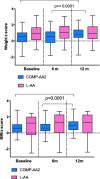Glycomacropeptide: long-term use and impact on blood phenylalanine, growth and nutritional status in children with PKU
- PMID: 30770754
- PMCID: PMC6377744
- DOI: 10.1186/s13023-019-1011-y
Glycomacropeptide: long-term use and impact on blood phenylalanine, growth and nutritional status in children with PKU
Abstract
In phenylketonuria, casein glycomacropeptide (CGMP) requires modification with the addition of some essential and semi essential amino acids to ensure suitability as a protein substitute. The optimal amount and ratio of additional amino acids is undefined.
Aim: A longitudinal, parallel, controlled study over 12 months evaluating a CGMP (CGMP-AA2) formulation compared with phenylalanine-free L-amino acid supplements (L-AA) on blood Phe, Tyr, Phe:Tyr ratio, biochemical nutritional status and growth in children with PKU. The CGMP-AA2 contained 36 mg Phe per 20 g protein equivalent.
Methods: Children with PKU, with a median age of 9.2 y (5-16y) were divided into 2 groups: 29 were given CGMP-AA2, 19 remained on Phe-free L-AA. The CGMP-AA2 formula gradually replaced L-AA, providing blood Phe concentrations were maintained within target range. Median blood Phe, Tyr, Phe:Tyr ratio and anthropometry, were compared within and between the two groups at baseline, 26 and 52 weeks. Nutritional biochemistry was studied at baseline and 26 weeks only.
Results: At the end of 52 weeks only 48% of subjects were able to completely use CGMP-AA2 as their single source of protein substitute. At 52 weeks CGMP-AA2 provided a median of 75% (30-100) of the total protein substitute with the remainder being given as L-AA. Within the CGMP-AA2 group, blood Phe increased significantly between baseline and 52 weeks: [baseline to 26 weeks; baseline Phe 270 μmol/L (170-430); 26 weeks, Phe 300 μmol/L (125-485) p = 0.06; baseline to 52 weeks: baseline, Phe 270 μmol/L (170-430), 52 weeks Phe 300 μmol/L (200-490), p < 0.001)]. However, there were no differences between the CGMP-AA2 and L-AA group for Phe, Tyr, Phe:Tyr ratio or anthropometry at any of the three measured time points. Within the CGMP-AA2 group only weight (p = 0.0001) and BMI z scores (p = 0.0001) increased significantly between baseline to 52 weeks. Whole blood and plasma selenium were significantly higher (whole blood selenium [p = 0.0002]; plasma selenium [p = 0.0007]) at 26 weeks in the CGMP-AA2 group compared L-AA. No differences were observed within the L-AA group for any of the nutritional markers.
Conclusions: CGMP-AA increases blood Phe concentrations and so it can only be used partly to contribute to protein substitute in some children with PKU. CGMP-AA should be carefully introduced in children with PKU and close monitoring of blood Phe control is essential.
Keywords: Glycomacropeptide; Large neutral amino acids; Phenylalanine; Phenylketonuria; Protein substitute.
Conflict of interest statement
Authors’ information
Authors information email and full names given on first page.
Ethics approval and consent to participate
We have gained Ethical approval and participant consent. The study was registered by the Health Research Authority and was given a favourable ethical opinion by the South Birmingham Research Ethical Committee. Ref nos 13/WM/0435.
Consent for publication
All subjects and authors have given informed consent for publication.
Competing interests
The study was funded as part of PhD grant. The authors: Daly A, Evans S, Pinto A, Rocha J, MacDonald A have received research grants and lecturing honoraria, consulting fees from various nutritional companies (Nutricia Ltd., Vitaflo Ltd., Merck Serono, Bio-Marin, Firstplay dietary foods, Mevalia, Cambrook Foods, APR, Eurocept, Arla). Francjan van Spronsen Nutricia Ltd., Vitaflo Ltd., Merck Serono, BioMarin, APR, Eurocept, and Arla international. Gingell C, Santra S, Chahal S, Jackson A declare no conflict of interest.
Publisher’s Note
Springer Nature remains neutral with regard to jurisdictional claims in published maps and institutional affiliations.
Figures
References
Publication types
MeSH terms
Substances
LinkOut - more resources
Full Text Sources
Medical




